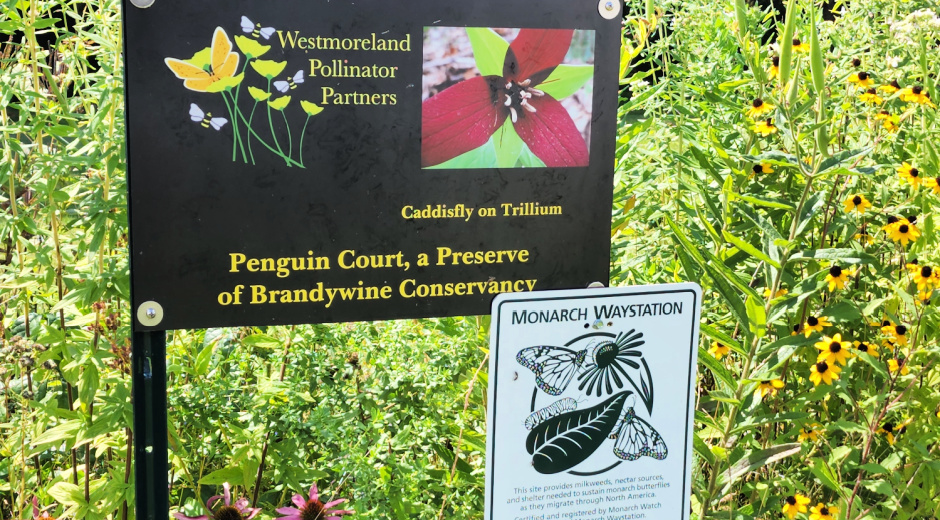Create a Backyard Butterfly Buffet with a Monarch Waystation
FirstEnergy funds waystations in celebration of Westmoreland County’s 250th anniversaryThe mighty Methuselah scans the landscape, zeroing in on a bright swath of gold, crimson and purple flowers below. It’s a blinking neon “EAT” café sign for this migratory monarch butterfly.
Summer’s fourth and final generation of monarch – known as the super or Methuselah generation – are robust specimens with powerful wings capable of flying thousands of miles south to Mexico, where monarchs winter over as part of the age-old cycle to sustain this majestic species.
Monarchs make countless pit stops to fuel up on nectar from native plants to survive this astounding journey. That’s where you can come in.
If you live or own property in Westmoreland County, Pennsylvania, and have 100 square feet of sunny space to spare in the yard – or some large containers on a patio or deck – consider hosting a monarch waystation.
Benefiting local environment
As part of its 250th Anniversary celebration, Westmoreland County seeks to establish 250 such waystations in 2023, joining hands with FirstEnergy and the Westmoreland Pollinators Partners consortium to reach the goal.
“Supporting pollinators is not new to FirstEnergy because our vegetation management practices are leading the way in helping pollinators prosper,” said Scott Wyman, president of FirstEnergy’s Pennsylvania operations, which includes local electric company West Penn Power. “Assisting Westmoreland County in its goal to establish 250 monarch waystations in 2023 is a fitting way to celebrate the county’s milestone anniversary.”
To date, 165 monarch waystations have been established in the county, putting the goal of 250 well within reach. Even relatively tiny refuges in urban or suburban areas can act as steppingstones linking larger monarch habitats.
Until the goal of 250 new waystations is achieved, a corporate donation from FirstEnergy and the county’s 250th Anniversary Initiative will cover the $18 certification fee and additional $18 cost for the metal monarch waystation sign that signifies your commitment to support the monarch and other pollinators.
Getting started
Monarch waystations feature two primary components to provide food and shelter: native milkweed plants and flowering nectar plants.
Monarch caterpillars feast on milkweed leaves to grow and mature into adult butterflies. To maximize effectiveness, monarch waystations should contain at least 10 milkweed plants of varieties native to Pennsylvania including common milkweed, swamp milkweed and butterfly weed.
Flowering nectar plants are the other key ingredient for a waystation. It is essential to plant a variety of nectar plants that bloom at various times, both for the stalwart long flyers that require energy to migrate south in the fall and for the earlier generation monarchs that breed and live out their entire four-to-six-week lifespans locally.
If you would like to have your habitat certified as a monarch waystation and join nearly 42,000 other recognized waystations worldwide, you may complete this application.
“Monarch waystations are a great way to introduce people who may not be nature savvy about ways to ‘rewild’ their backyards to attract pollinators,” said Melissa Reckner, a local conservationist who is directing the local waystation effort in Westmoreland County. “Everyone has monarch memories or remembers blowing milkweed fluff when they were kids.”
Performing a few habitat management chores is necessary for your waystation to succeed. Work may include watering as needed to establish new plants; removing invasive plants; mulching to suppress competitive plants; and avoiding the use of pesticides.
Monarchs might need a couple seasons to discover the new neighborhood. “Just because you build it, doesn’t mean monarchs will come right away,” Reckner said.
No worries. In the meantime, monarch waystations also feed and shelter other beneficial pollinators like milkweed beetles, bees and birds.
Continued efforts
FirstEnergy’s support of monarch waystations in Westmoreland County is in addition to a companywide initiative to develop 225 acres of pollinator habitat across its service territory by 2025, including the creation of new habitat in transmission right of ways, at its utility substation properties and at parks and nature preserves.
For more information about FirstEnergy’s environmental and corporate responsibility efforts to build a brighter and more sustainable future, visit www.fecorporateresponsibility.com.
NEWS CONTACT: Todd Meyers, (724) 838-6650

